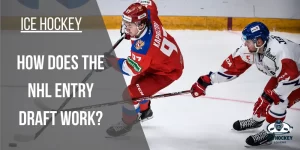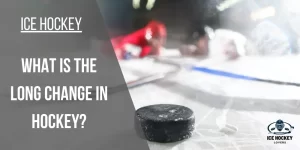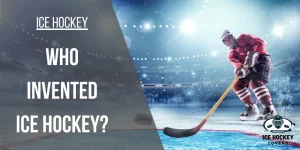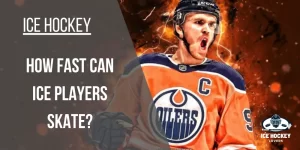Ice Hockey Rules | A Beginner’s Guide to Hockey 101
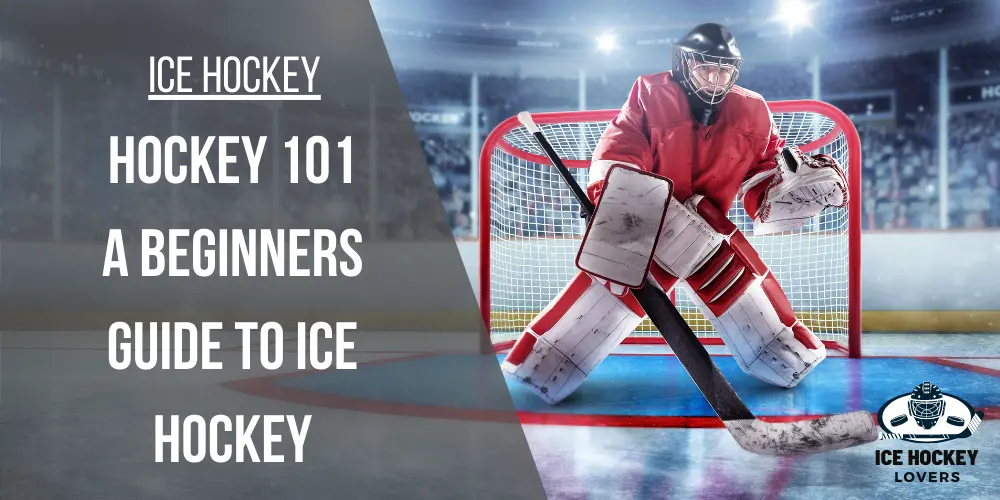
People learn and excel when they are passionate and committed to their passion. For a sports enthusiast, the keys to a good game are knowing the basics and then applying the rules in the game. Sports are not just for fun and relaxation. However, they teach life lessons to those paying attention and always come with some basics for playing the game.
No doubt, in the beginning, it cannot be very clear for a newbie to understand the basics of that sport. Therefore, I compiled a simple guide to the essential hockey rules you must know before watching or even playing the sport to make it easier for hockey fans. This essential guide will undoubtedly help you learn the know-how about hockey rules and the strategic terms players and teams employ to win the game.
Moreover, to keep things simple for newbies, I linked most key topics to read and understand in-depth. You can click on the link and get detailed information about that. So, coming to the basics of ice hockey.
Table of Contents
The object of the Game
In Ice Hockey or any other sport, players simply focus on winning the game. To win the ice hockey game, players must shoot the puck to the opponent team’s goal and score more goals than their opponent in the match.
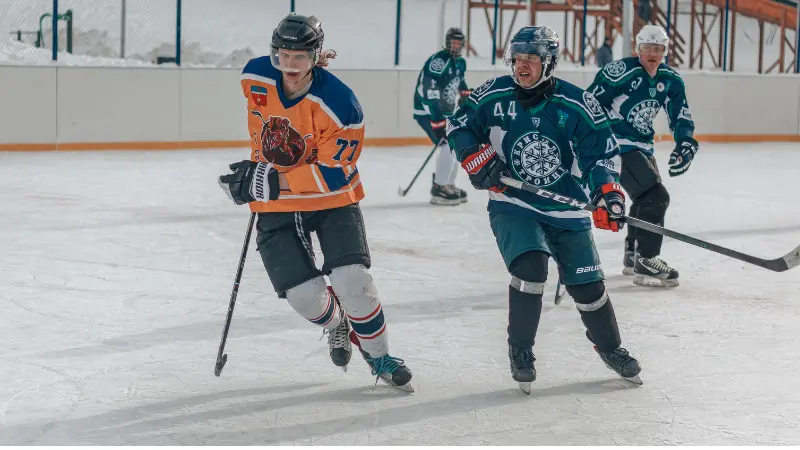
As time passes on, the situation becomes more complex. Usually, teams create strategies to get more goals while training their defenders not to allow the opposition to score.
The Team and Players
In professional leagues like the NHL, each team is allowed to dress 20 players for a game. Typically, the team consists of 6 defensemen, 12 forwards, and 2 goalies (one goalkeeper plays while the other is a backup goalkeeper who usually sits on the bench and is available in case of injury).
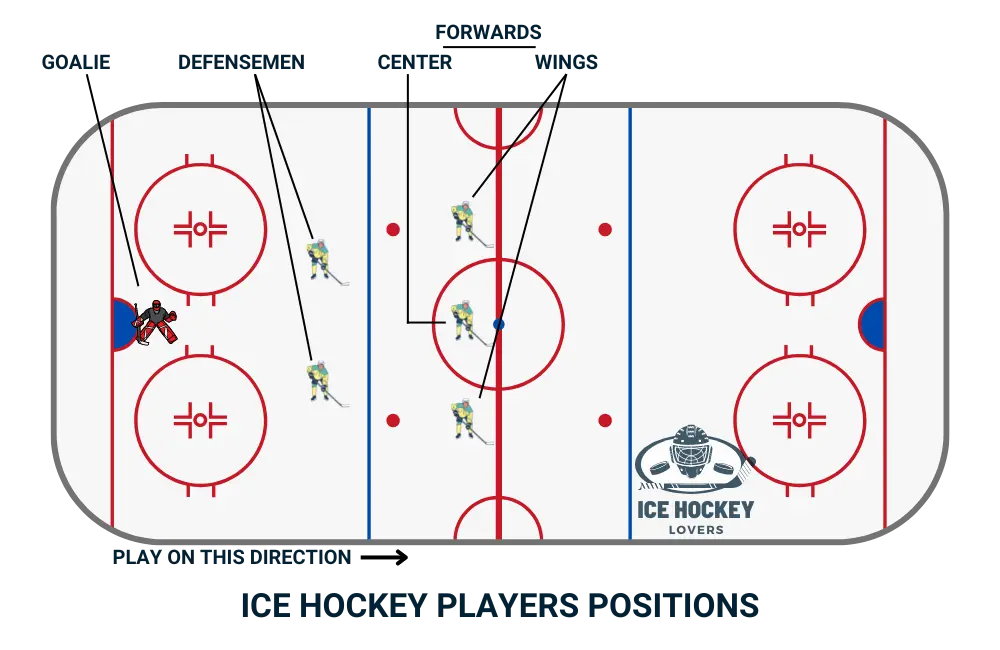
Usually, the ice hockey teams play with 5 vs. 5, along with a goalie. In the rink, 5 players are divided into 3 forwards, 2 defensemen, and 1 goalie. (to read more in-depth about how many players are on the ice?)
The following are the responsibilities and roles of each position on the ice hockey team:
Forwards
- Their primary responsibility is scoring goals.
- A total of 12 forwards is divided into four lines with three players each. A coach can switch players to different positions anytime in the game.
- The three positions of forwards are Center, Right-wing, and Left-wing.
- The center is the most critical position, facing all face-offs and significant defensive responsibility.
- The mutual responsibility of forwards is to support defensemen and goalie to prevent goals in their net side.
Defensemen
- Their main task is to prevent the opposing team’s attacks and goals.
- A total of six defensemen play in three different pairs. The coach can change their position anytime in the game, but they prefer to keep players in the same positions.
- Two defensemen positions: right defensemen and left defensemen are there having the same responsibility. However, coaches opt to put the right-shooting defenseman on the right and the same with the left as it is easier for the defensemen to pick up the puck from the stick and shoot.
- Defensemen help the forwards as extra attackers in the offensive zone by rushing the puck up the ice. The most skilled usually get the Norris trophy for doing it at best.
Goalies
- Goalies come with many unique perks, as they have the privilege to hold the puck and stop the game because their main job is to stop the puck from getting into the net.
- They have specially designed equipment to prevent the puck – padding, sticks, and gloves.
- A goalie is not permitted to contact or touch inside the crease. (What happens if you hit the goalie?)
- A goalie is the only player with the authority to stop the game.
Points – Goals, and Assists
The winning team is decided by the number of goals they scored. Each scored goal can get divided into three parts: the scored goal, primary assist, and secondary assist. Each of these gets the point. (Read about the points and how many to expect from a player in a game or season.)
- A sample goal score looked as follows: Goal – Sidney Crosby (Malkin, Letang)
- It indicates that Crosby scored the goal, assisted by Evgeny Malkin and Kris Letang.
- An assist is named to the last two players who touch the puck when the final player scores the goal.
- Not all goals have assisted, and some may have only one assist.
- Goals and assist are combined and count as one point for the player’s overall stat.
Time Structure of the Game
Hockey games consist of 60 minutes. Each game has three time periods, and each period is 20 minutes long. There is a 15 minutes intermission time after each period. (Is there ever a reason why ice hockey has three periods?). The total time of hockey games differs at different levels because of certain factors like injuries, penalties, etc.

In professional and high-level amateur leagues, the stop time is 60 minutes played, indicating that the clock will also stop when the referee blows the whistle to stop the game and will resume only when the game continues. However, in recreational hockey, 60 minutes are the game run time. The clock will not stop, with the referee blowing the whistle. It would only stop at the period’s end. Moreover, read how long an ice hockey game lasts on different levels.
Timeouts: Each team is allowed one 30 seconds timeout per game. This timeout is usually reserved for the end of the game if the coach wants to call it for a particular strategy session to tie up the game and give his offensive players some rest.
The Officials
Four officials are in charge of running a game in accordance with the NHL rules, two linesmen and two referees. Whenever there is a rule breakage, the officials blow the whistle, a signal to stop the game.
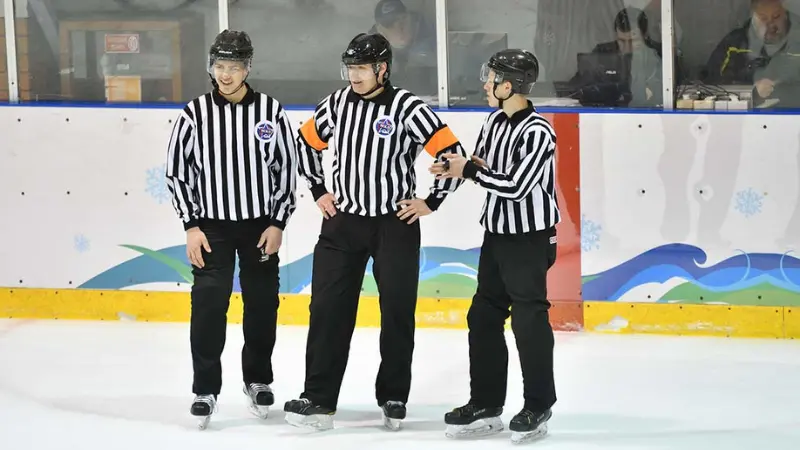
Match infractions are of two types. One is when a player gets penalized for two minutes and 5 minutes. The other type is when a game stops and again starts with a face-off.
- Linesmen are in charge of non-penalty infringements, off-sides, and icing.
- Referees: are responsible for overseeing the penalty infractions such as allowing or disallowing the goal or any other rules that result in the player setting off the ice.
Four officials monitor the hockey games. These are the two referees and the two linesmen. The linesmen oversee infractions that do not result in penalties, while the referees watch over the offenses resulting in penalties and determine the goals.
Hockey Rink and Lines
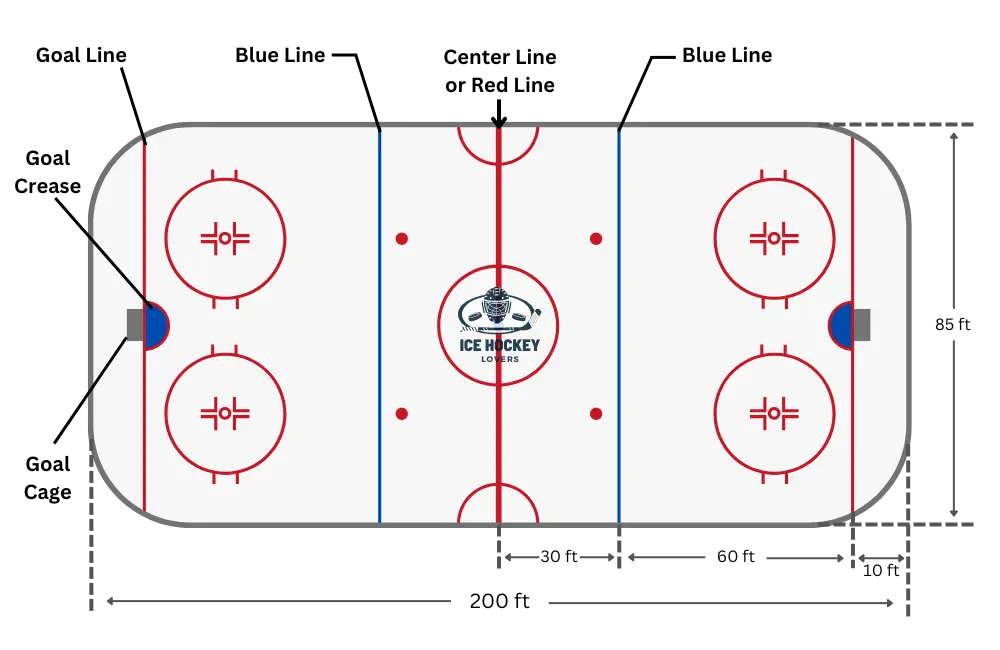
A hockey rink is divided into five lines that go from one side of the net to the others side, with nine – 9 face-off dots placed on specified areas on the ice. Five lines are there to decide when a play should get paused, and red dots are used for the face-off to resume the game.
Let’s get some brief information about rink lines.
Blue Lines – Offside
Blue lines help the defensive side by limiting the other team not come across randomly on this side of the ice. Blue lines act as a safeguard in front of the offensive team. It forces the teams to shoot the puck past the blue line before any player crosses it and goes to the board ends.
The player’s puck must have crossed the opposite side before the player himself, and if both the skates of a player cross the opposite side without the puck, offside is called, resulting in a faceoff.
Another form of offside is a two-line pass when a player receives the pass by crossing a blue line and the center red line before touching it. Check out the comprehensive guide on offside work in ice hockey.
Red Lines – Icing
Icing is the third rule of the game, resulting in a faceoff the game. This rule is vital to make hockey quick without wastage time. If a player from one team shoots the puck into the opposite team’s side and the puck crossing the goal line is touched by any team player other than the goalie, Icing is called on the team that attacked.
Hockey does not consider it reasonable to directly shoot the puck to the other end as a defensive strategy to neutralize the offensive attack pressure. This would abrupt the game flow and limit the scoring chances. Thus, hockey management draws these red lines, not allowing the teams to directly shoot the puck passing through across the ice, which is generally called Icing. To understand the icing rule read out the comprehensive guide.
A player must pass the big center red line to shoot the puck into the other team’s nets. Icing is waived off if the goalie or the attacking team touches the puck.
Goalies Special Lines – Trapezoid and Crease
- The Crease is the area painted in front of the goal net assigned to the goalie. Players are allowed to go into it to reach the goal, but they are not allowed to impede the goalie because any connection with the goaltender is termed goalie interference, which may call a penalty.
- The Trapezoid is the area behind the goal net, given to the goalie. A goalie can play the puck in front and behind the net but not at the sides or edges of the rink. Considering the goalie’s expert puck-handling skill, who turned himself into the third defenseman, this rule has been instituted, allowing the offense to establish some time to play with the puck on the offensive side.
Goal Line
The most important line for the teams is the direct line in front of the net. The two significant things that teams are doing in the game are to either stop the opposing team from entering their side of the goal line or to enter into the opposing team’s goal line.
Faceoffs
Faceoff is like a battle for the possession of the puck. As soon as the official drops the puck between the teams, both team players rush to take the puck. Players try their best to get the puck and shoot it into the opponent’s net. Sometimes players get kicked out from taking a faceoff: here is why?
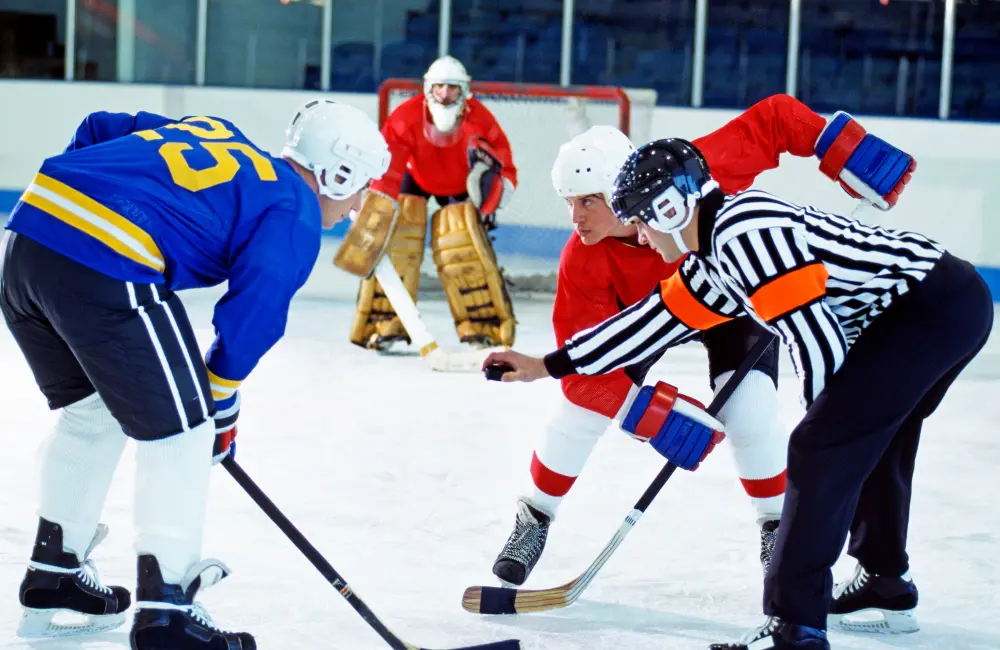
During the face-off, one player from both sides comes before the other, and all other players stand aside. The moment the puck touches the rink, the players can then move anywhere on the ice rink to play with the puck.
Here are some spots where faceoff takes place in different scenarios.
- The center faceoff circle is used at the start of the period and when there is a goal.
- The four faceoff dots are used when there is an offside call.
- When a goalie stops the game, a faceoff circle nearest to that goalie is used.
- A faceoff circle in the penalized team zone is used when a team comes under a penalty.
- When a team does Icing, a faceoff circle in the team’s zone responsible for Icing is used.
Penalties in Ice Hockey
Whenever any player other than the goalie gets hold of the puck, it is necessary for them to immediately either knock or place it back down to the ice; otherwise, there is a penalty of a two-minute minor.
The team rewards a penalty if a player is pulled down from behind or the net is deliberately dislodged.
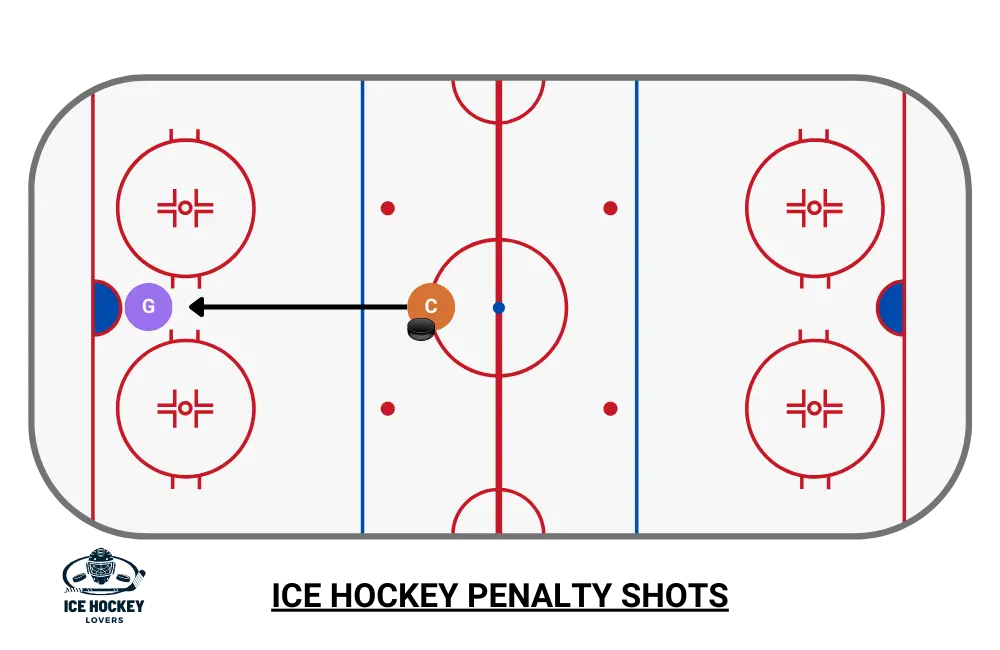
- Minor Penalty: is of 2 minutes that generally calls for tripping, holding, lashing, interference, high sticking, and game delay.
- Major Penalty: is of 5 minutes. In general, these penalties are the same as minor penalty infractions. The referee decides how severe or graves the misconduct is, and then the referee calls for 5 minutes penalty.
- Match Penalty: This is another 5 minutes penalty that results in a player removing from the game for attempting or deliberately injuring other players.
- Misconduct Penalty: it is an extended 10-minute penalty, but it does not make the team short-handed.
- Penalty Shot: It is one of the rarest things awarded to a player when he gets interfered with from the back when he is in his shot of shooting a goal. In a penalty shot, he hits the puck from the center without the hindrance of any player. There is only a goalie. How exciting is that to watch!
Are you curious to learn more about penalties in detail? Check out the complete guide to penalties.
- Power Play: The most wanted moment, power play, comes like a blessing for one team when another team faces a Penalty. Hence, the power play team plays with their entire team having more men over the short-handed penalty team, which play with fewer players, such as 5 vs. 5, and 4 vs. 3.
- Penalty Kill: This is the opposite of the power play. It played the same as 5 vs. 4 or 4 vs. 3 but look at it from the other team on Penalty. A team plays short-handed, but the players will never be less by 3.
Overtime and Shootout
Hockey games do not end in a tie, so if a hockey game ends in a tie, it is decided through two different periods; overtime and the shootout. Overtime is a five-minute additional time after the regulation, in which the teams play three vs. three formats to determine the winner of the game.
The most exciting thing about overtime in regulation is that players play in the three vs. three formats instead of the five vs. five formats. This change of format brings many scoring opportunities.
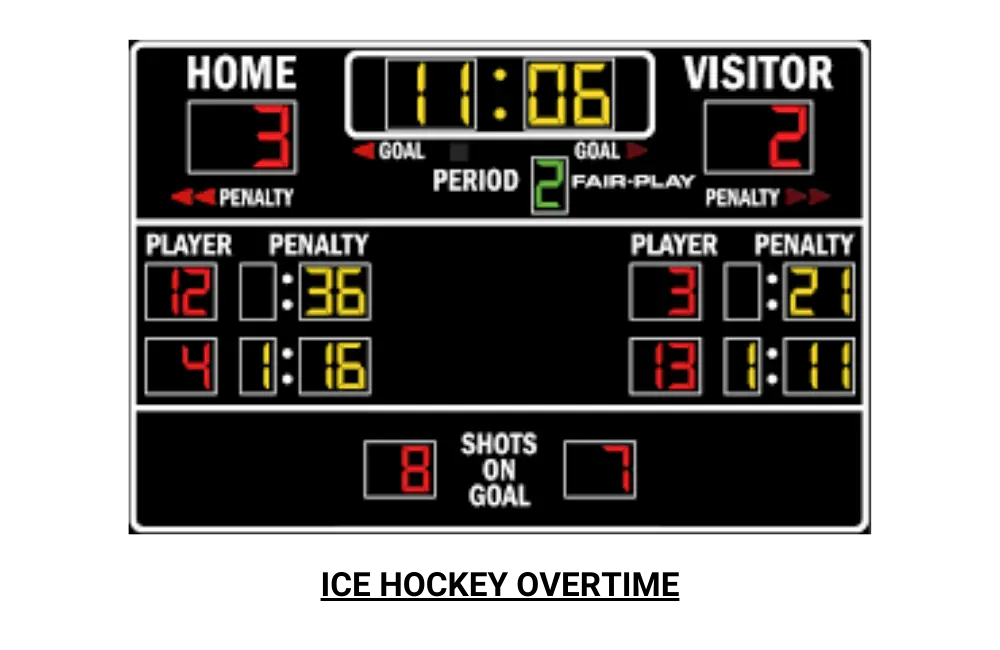
Overtime is like a sudden death in hockey because once a team scores, the game stops. Check out to learn more about overtime work in ice hockey.
If the overtime also ends in a tie and there is still no winner in the game, then a shootout will decide the game’s fate. Each team selects three players in the shootout, and each gets a take on to shoot the puck, a breakaway chance without any hindrance against the opposing goaltender. The team with the most goals would win the game. If the game still ends in a tie after the shootout, then the teams will keep selecting players to shoot the puck in the shootout until a winner is determined. Note that there is a difference between the shootout and the penalty kill.
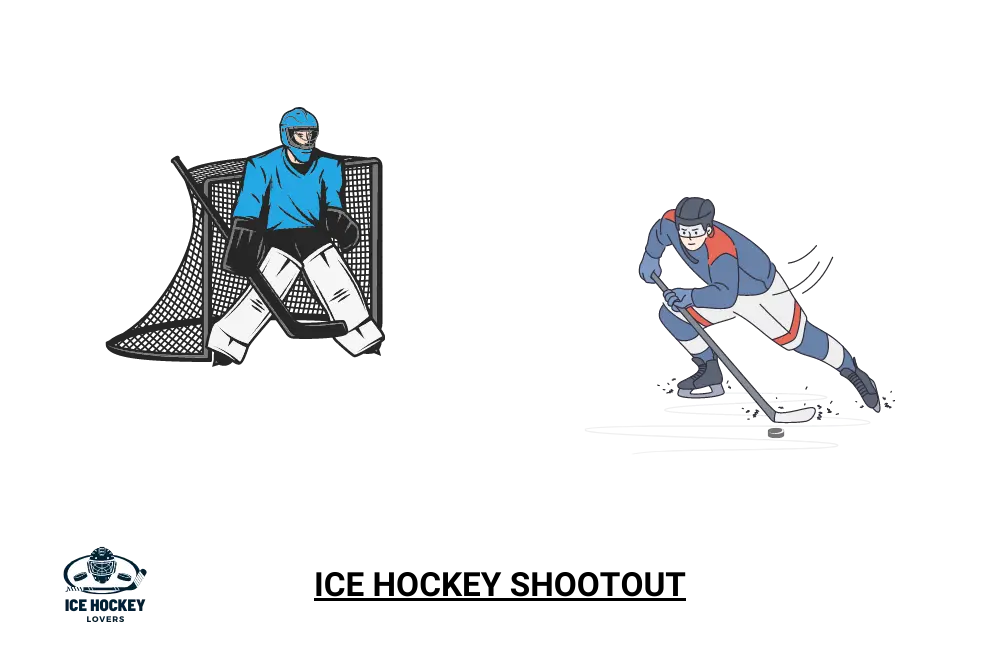
In playoffs, the additional time is about 20 minutes to determine the winner. Also, teams play with the same five vs. five formats, unlike the three vs. three formats in regulation. That makes it less triggering and exciting compared to the overtime in regulation.
I love the overtime and shootout the most, and I’m sure other fans are crazy about this part of the game too.
Line Changes
The exciting thing about the ice hockey game is that players can change at any time while playing the game, unlike other sports, such as football, where players wait for the game stoppage to change.
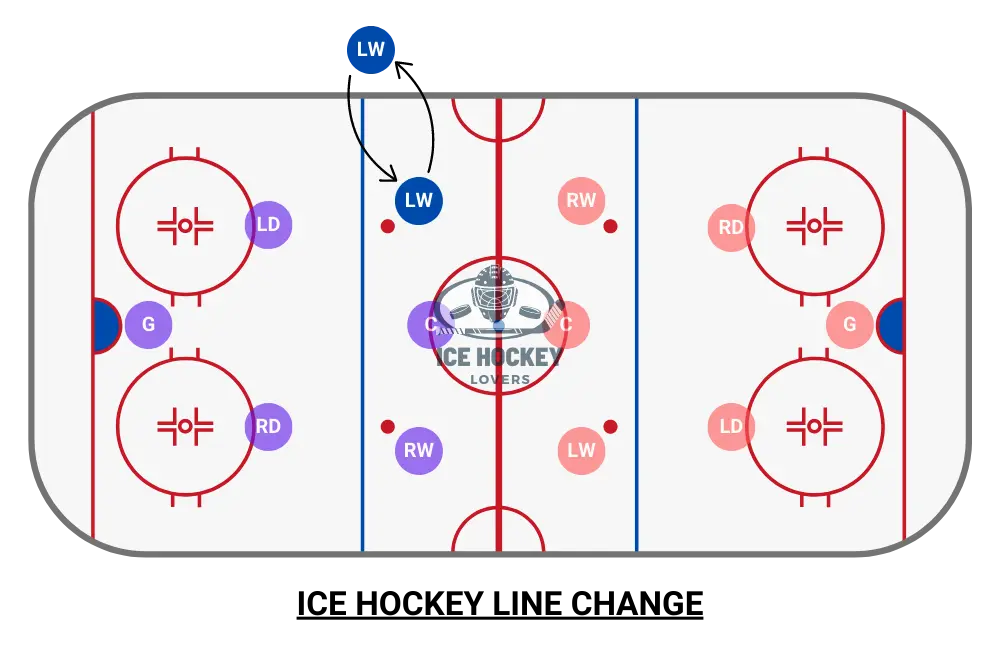
The “Change on Fly” is used for players to replace during the game. Players can substitute off the ice when the game is in action. But there is a difference between the simple changing during play and a change on Fly. Are you wondering how players know when to change?
The Change on Fly requires a thorough sense of the game. While on change on Fly, time, intensity, action, and flow of the game must be kept to keep the high energy and balance of the game. So, each player plays well in their position while others are changing.
Other equipment is shoulder and arm pads, elbow pads, and gloves. Hockey pants, shin pads, and hockey socks are also mandatory for all players and are designed especially for their protection.
There are also ice skates, a jersey, and a chest and arm protector in the equipment kit. And last but not least are blockers, catch gloves, and leg pads. All the equipment is designed so players can play easily on the ice, and their body parts are protected from severe harm or debilitating injuries.
Conclusion
In conclusion, here is a comprehensive guide to ice hockey rules. It will help you understand the basics and enhance your knowledge of ice hockey. At the same time, you can also learn the nitty gritty of ice hockey and understand the other terms of the game by exploring the website.

Who is Austin Taylor?
Meet Austin Taylor, your go-to source for everything ice hockey! With a passion for the sport that’s as deep as the ice itself, Austin Taylor brings you concise, expert insights and nitty-gritty details on all things hockey. From gear reviews to strategy breakdowns, Austin Taylor is your trusted guide to navigating the exhilarating world of ice hockey. Get ready to lace up your skates and dive into the game with Austin Taylor as your ultimate companion.

